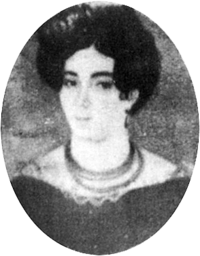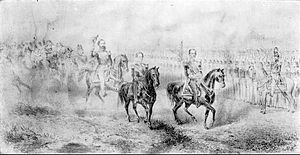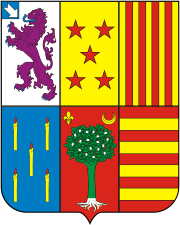Luís Alves de Lima e Silva, Duke of Caxias
Again breaking with his father and other relatives sympathetic to the rebels, from 1839 to 1845 Caxias commanded loyalist forces suppressing such uprisings as the Balaiada, the Liberal rebellions of 1842 and the Ragamuffin War.[15] Having fought against the Spaniards on Brazil's southern frontiers,[14] he secured a place for himself in Rio de Janeiro's upper class when he married a member of a local and influential family.[17] King Dom João VI embarked upon a series of wars of conquest which resulted in the expansion of Brazil's territory with the annexation of Cisplatina to the south and of French Guiana to the north.[12][22] Historian Adriana Barreto de Souza explained that this did "not mean that he began to serve as a child, the connection to the regiment was simply honorific", his perquisite as the son of a military officer.[27] The subjects he studied in the Royal Military Academy ranged from arithmetic, algebra and geometry to tactics, strategy, camping, fortification in campaign and terrain reconnaissance.[39] On 18 January 1823, Pedro I created the Emperor's Battalion, a handpicked elite infantry unit[40][41] that included Luís Alves, who was named as adjutant to the company's commander, his uncle, Colonel José Joaquim de Lima e Silva.[66][67] The army, "demoralized by the far from exemplary part it had played in the April Revolution [i.e. Pedro I's abdication]," said historian C. H. Haring, "became the ready tool of any popular agitator or demagogue, and often the source of riot and sedition.[78] According to historian Heitor Lira, Luís Alves was "one of the rare, sincere and profoundly convicted monarchists and friends of the King [i.e., the Emperor] and of the Dynasty [the House of Braganza].[76] Meanwhile, Honório Hermeto Carneiro Leão (later Marquis of Paraná, a distant cousin of Caxias's wife[89] and a leader of the Reactionary Party) sent letters to Luís Alves attempting to undermine the influence Francisco de Lima had on him and to dissuade him from supporting the unconstitutional proposal to declare the Emperor of age.With the aid of National Guard units from Rio de Janeiro under its president, Honório Hermeto, Caxias was once again successful, and by late August, the rebellion was crushed.[98] Although his move toward the saquarema camp was not clear at the time he accepted the appointment to put down the rebellion in Maranhão in 1839, his victory over the Liberal rebels in 1842 further solidified his allegiance to the Party of Order.[99] When the republican secessionist rebellion known as the Ragamuffin War began in Rio Grande do Sul in 1835, João Manuel de Lima e Silva, one of Caxias's uncles, joined the rebels."[103] Caxias brought with him a fellow saquarema and a famous poet, Domingos Gonçalves de Magalhães (later Viscount of Araguaia), to serve as his secretary, as he had previously in Maranhão.The Minister of Foreign Affairs, Paulino Soares de Sousa (later Viscount of Uruguai), forged an anti-Rosas alliance between Brazil, Uruguay and rebel Argentine provinces.[129][130] Caxias spent 17 January aboard the frigate Dom Afonso alongside John Pascoe Grenfell, taking stock of the port area of Buenos Aires, the Argentine capital, selecting the best place to launch an amphibious attack.The Law of the Circles and the controversy surrounding it split the Conservative Party: one faction was the saquarema ultraconservative (or traditionalist) wing, then called the vermelhos (reds) or puritanos (puritans), led by Eusébio de Queirós, Uruguai and Joaquim Rodrigues Torres, Viscount of Itaboraí.During the years following 1857, successive cabinets quickly collapsed, unable to muster a majority in the Chamber of Deputies, as the two Conservative wings undercut each other in a fight for dominance.[144] Among his ministers were José Maria da Silva Paranhos (later Viscount of Rio Branco), whom Caxias had met and befriended during the Platine War while serving as secretary to Paraná.His warnings were ignored, and he complained, with a bit of irony, to his friend João Maurício Vanderlei, Baron of Cotejipe, a former colleague in the Conciliation cabinet: "I am almost mad with the mistakes that I am seeing being made, but since I am a red [ultraconservative or traditional saquarema] I am not listened to, since everything is progress in our country.The Progressive cabinet decided to create a unified command over Brazilian forces operating in Paraguay, and it turned to the 63-year-old Caxias (made permanent army marshal on 13 January)[158] as the new leader on 10 October 1866.[178] Pressing his advantage, the marquis began organizing an assault on the new Paraguayan defenses which López had thrown up along the Pikysyry, south of Asunción (Paraguay's capital).This stream afforded a strong defensive position which was anchored by the Paraguay River and by the swampy jungle of the Chaco region, both considered to be nearly impassable by a large force.Opponents represented the interests of powerful coffee farmers such as Caxias, planters who had long been the main political, social, and economic supporters of the Conservative Party.[196] As Catholicism was the state religion, the Emperor exercised, with the papacy's acquiescence, a great deal of control over church affairs—paying clerical salaries, appointing parish priests, nominating bishops, ratifying papal bulls, and overseeing seminaries.Unlike their predecessors, they had no experience of the regency and the early years of Pedro II's reign, when external and internal dangers threatened the nation's existence; they had only known a stable administration and prosperity."[122] Confined to a wheelchair as his health slowly declined, the Duke of Caxias lived his remaining days at Santa Mônica farm, located near the town of Valença, in the countryside of Rio de Janeiro province.[223] According to Adriana Barreto de Souza,[225] Francisco Doratioto[226] and Celso Castro,[227] Caxias supplanted Osório because he was seen as a loyal and dutiful officer who could serve as a role model in a Brazilian republic plagued since its birth in 1889 by military insubordination, rebellions and coups."His name", said the historian Thomas Whigham, "has become synonymous with the upright officer and citizen who never breaks the law—hence the popular term caxias, which refers to individuals who follow regulations without mistrust, doubt and evasion.Francisco Doratioto said that the duke "in Paraguay had doubts, pride, resentment, and made mistakes; in short, he was a real character ... Caxias, however, was able to rise above his limitations, imposed on himself great personal sacrifices and incorporated the responsibility of accomplishing the objective ..."[232] Roderick J. Barman affirmed that Caxias was not only "extremely powerful in the Conservative party",[233] but also "the country's most distinguished"[152] and "most successful soldier",[234] who had "proved his capacity and his loyalty by defeating revolts against the regime".















Duque de Caxias, Rio de JaneiroDuque de Caxias (disambiguation)Portuguese namefamily nameHis ExcellencyPrime Minister of BrazilPedro IIViscount of Rio BrancoViscount of SinimbuBaron of UruguaianaZacarias de GóisMarquis of ParanáMarquis of OlindaMinister of WarJosé Antônio SaraivaCount of Porto AlegrePresident of Rio Grande do SulPresident of MaranhãoDuque de CaxiasRio de JaneiroState of BrazilPortuguese AmericaValença, Rio de JaneiroEmpire of BrazilConservativeImperial Brazilian ArmyField MarshalBrazilian War of IndependenceCisplatine WarBalaiadaLiberal rebellions of 1842Ragamuffin WarPlatine WarParaguayan WarBrazilian War for IndependenceCisplatinaPedro IabdicatedPedro IIswordsmanshiphorsemanshipregencyArgentine ConfederationnobilityConservative Partypresident of the Council of MinistersManuel Luís Osório, Marquis of ErvalBrazilFrancisco de Lima e Silvaarrival of the Portuguese Royal FamilyJoão VIFrench GuianaOrder of ChristPedro II SchoolRoyal Military AcademytacticsstrategyIndependence of BraziladjutantPierre LabatutSalvadorMontevideoUnited Provinces of the Río de la PlataArgentinaUruguayFrancisco DoratiotoRegency period (Empire of Brazil)Miguel de Frias e VasconcelosIlha das CobrasHouse of BraganzaEusébio de QueirósBernardo Pereira de VasconcelosMaranhãoSão LuísCaxiasHonório Hermeto Carneiro LeãoSabará1842 Liberal rebellionaide-de-campbrevetRio Grande do SulJoão Manuel de Lima e SilvaDomingos Gonçalves de Magalhãesguerrilla warfarecounterinsurgencyBuenos AiresplantationJuan Manuel de RosasPaulino Soares de SousaManuel Marques de SousaBattle of CaserosDom AfonsoJohn Pascoe Grenfellamphibious attacklieutenant generalSeptember 6, 1853 cabinetpresidentJoaquim Rodrigues Torres, Viscount of ItaboraíJosé Maria da Silva Paranhoslower houseProgressive Leaguearmy marshalaides-de-campFrancisco Solano Lópezintervention in UruguayParaguayan armyMato GrossoMato Grosso do SulArgentineJoão Maurício Vanderlei, Baron of CotejipePorto AlegreUruguaianafortifications at HumaitáParaguay RiverJoaquim Marques LisboaJoaquim José InácioAlfredo d'Escragnolle Taunayobservation balloonssurround HumaitápassagePikysyry maneuverbecame a political crisisAsunciónChaco regionoutflank the Paraguayan linesYtororó